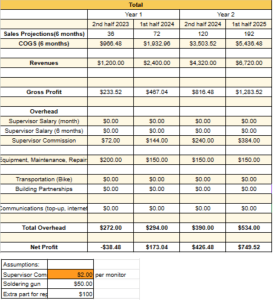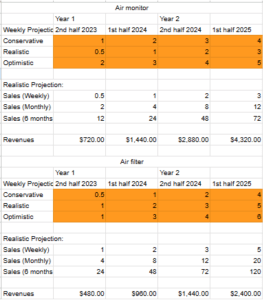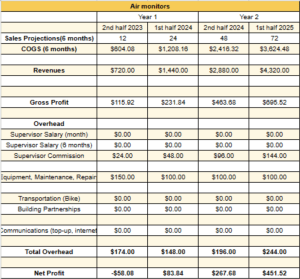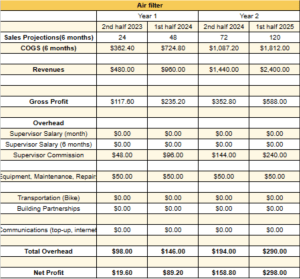Fall Semester Blog Post #1
STOP/Fieldwork & Mountaintop reflection
- Achievements
- Fieldwork
- Multiple contacts in Almaty
- Divided up our project into specified teams
- IRB
- Challenges
- Communication with Kazakhstan team
- Communication with Hong Kong team (air filter)
- Further Plans
- Regularly meet with our teams at Haileybury
- Conduct study
- Plan forms of outreach
CINQ 388 Ethical Decision-Making Methodology
Step 1: Determine the facts in the situation – obtain all of the unbiased facts possible. Clearly state the ethical issue.
- Facts:
- Without auto-disable safety feature → low cost (accessible) + risk of spreading disease
- With auto-disable safety feature → higher cost + safety
- Ethical issue:
- Should we prioritize accessibility or safety?
- Should I help 10 people or should I help 100 people although certain amount of people might be exposed to another disease?
- Should we prioritize accessibility or safety?
Step 2: Define the Stakeholders – those with a vested interest in the outcome
Step 3: Assess the motivations of the Stakeholders
- Hospitals/clinics – primary stakeholder – customer
- Interest: Helping those who are in need to achieve and maintain their optimal health; sustaining their operation through financial security
- Patients – primary stakeholder – end user
- Interest: Achieving and maintaining their best health; having access to health services regardless of their socioeconomic status (health equity)
- Designers/manufacturers/insurance companies – secondary stakeholders
- Interest: Using technology to better human life; making profit to sustain their business
- Government/regulatory body – secondary stakeholders
- Interest: Securing the safety of the country and its citizens; serving the best for its citizens
Step 4: Formulate (at least three) alternative solutions – based on information available, using basic ethical core values as guide
Approaches [1/2/3: repeat for every action]
- Potential solution: Designing the high-cost syringe and finding funding to make it accessible
- Ethical Principle or code: Duty-based thinking
- Pros: Safe health practice can be established
- Cons: Needs the involvement of third stakeholder (government + insurance companies) to step in and manage the financial aspect of the product to secure the accessibility among general public
- Potential solution: Designing the low-cost syringe and formulating disposal instructions/regulations
- Ethical Principle or code: Consequence-based thinking
- Pros: As accessibility is secured, many more people can be helped regardless of their socioeconomic status.
- Cons: Needs to practice strong disposal regulations to prevent possible spread of disease
- Potential solution: Design both syringes and let people make their own decisions
- Ethical Principle or code: duty-based thinking
- Pros: People will have choice.
- Cons: Those with lower socioeconomic status will be disproportionately affected by the possible spread of disease through low-cost syringe.
Step 5: Seek additional assistance, as appropriate – engineering codes of ethics, previous cases, peers, reliance on personal experience, inner reflection [RESEARCH the necessary informations]
- WHO guideline: Safety-engineered syringes to prevent re-use
- CDC guideline: Syringes should be discarded after single use and should not be re-used
- Incidence of syringe transmitted diseases: Acute hepatitis C virus cases rose 3.5-fold from 2010-2016 and majority of new cases are due to injection drug use.
- The growth market for disposable syringes: With this growth comes cheaper costs, which could aid in solving this problem
Step 6: Select the best course of action – that which satisfies the highest core ethical values. Explain reasoning and justify. Discuss your stance vis-a-vis other approaches discussed in the class.
- Designing both high and low-cost syringes to secure both accessibility and safety, and also working with third stakeholders to formulate and reinforce strict regulations on syringe disposal to prevent misuse
- Pros:
- Making options available
- Securing safety through safety feature in high-cost syringe and safety regulation in low-cost syringe
- Incorporating both consequence and duty-based thinking
- Prioritizing both safety and accessibility
- Cons:
- Needs third party involvement on regulations to prevent possible health disparity
- Pros:
Step 7: (If applicable) What are the implications of your solution on the venture. Explain the impact of your proposed solution on the venture’s technology, economic, social and environmental aspects. An abridged version (6-step) of the 9-Step Process from “Applied Ethics Case of the Month Club”; adapted from methodology developed by Andy Lau @ Penn State.
- Technology:
- High-cost syringe: using technology to better human life
- Low-cost syringe: less technology to decrease the cost
- Economic:
- High-cost: designers and manufacturers and make profit and sustain their business
- Low-cost: everyone will have access
- Social: reducing health disparity by introducing low-cost product and strong regulations
- Environmental:
- Low-cost: could lead to less pollution because it has less parts





